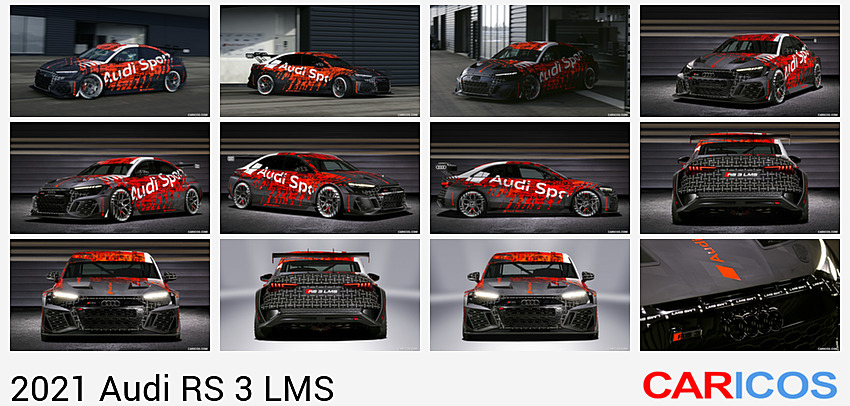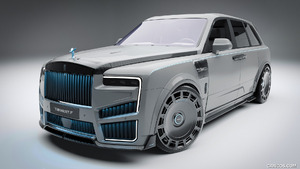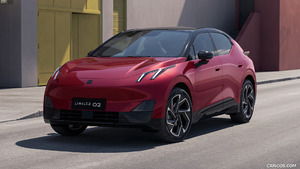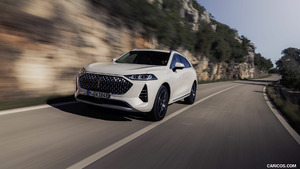Audi RS 3 LMS
Audi Sport customer racing unveils the successor to its successful RS 3 LMS model in January 2021. The second generation of the entry-level touring car will initially undergo a testing season before going into production and being ready for customers at the end of 2021. The model, which has been improved in many areas, is set to continue a series of great successes of the first generation in international TCR touring car racing, both in sporting and commercial terms. The focus during development was always on optimum customer benefit.
The Audi RS 3 LMS, which has been offered since the end of 2016, stands for records in the Audi Sport customer racing model range. No other model has been produced as in such large numbers in a single vehicle generation as the RS 3 LMS, of which 180 units were built. And no model with the four rings is currently used more frequently by customers around the world in racing than the compact four-door model. Up to the end of 2020, the model made 3,105 appearances in a total of 1,051 races around the globe in its life cycle to date. On average, there were almost three Audi RS 3 LMS cars on the grid in each race. A remarkable achievement in a category that is exclusively for customers and in which Audi has not been involved on the factory side with the exception of a two-year program in the FIA WTCR in 2018 and 2019. In the four years since its launch, the race car has clinched a total of 764 podium places in Africa, North and South America, Asia, Australia and Europe, including 279 victories. This is a win rate of 26.5 percent in an extremely tough competition in which TCR race cars from up to 14 manufacturers go head-to-head. 16 drivers titles, 38 further championship successes and a total of five class victories in 24-hour races characterize the sporting record of the entry-level model, which was the global “TCR Model of the Year” in 2018.
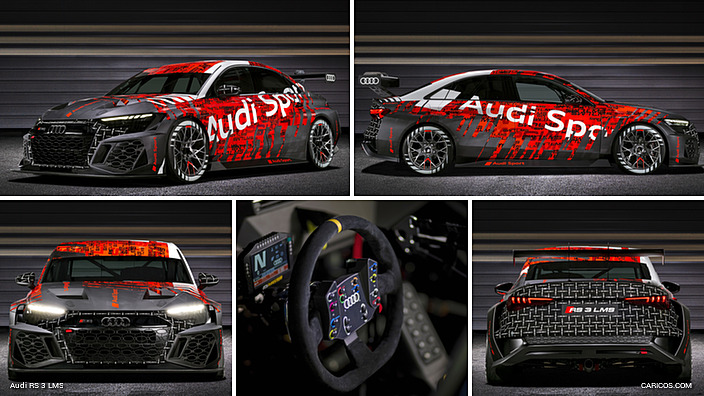 2021 Audi RS 3 LMS
2021 Audi RS 3 LMS
“Our new Audi RS 3 LMS thus takes on a great and responsible legacy,” says Chris Reinke, Head of Audi Sport customer racing. “The focus of our development goals for our latest model was on the customers. Whether it’s about running times or setup options, safety or cockpit ergonomics: we want to offer the teams a car that’s even more of a race car than before, that has many practical advantages in everyday use and that can be operated economically thanks to long running times.” Customers all over the world benefit from a comprehensive service network, a reliable supply of parts and the continuous further development of the race car over the course of its model lifecycle.
The TCR category offers beginners as well as gentleman drivers, but also touring car professionals, cost-effective racing with production-based models. The WSC organization currently has 24 national, regional and international TCR racing series and classes licensed worldwide, in most of which the Audi RS 3 LMS has been firmly established on the grid for a long time. In addition, teams use the race car for other programs in many regions, primarily in endurance racing in mixed sports and touring car series. TCR touring cars have long since become firmly established in classic racing nations as well as in emerging countries. Hardly any other category is so widespread in global motorsport.
With the second generation of the RS 3 LMS, Audi is committed to the continuity of an entry-level model in its vehicle range, a low-cost discipline in racing, customer racing as a central pillar in this class, and predictability and consistency vis-à-vis a loyal customer base worldwide. Multiple examples prove that Audi’s race car is also ideally suited for national retail organizations, and even individual dealers, to raise their own profile in the market in an affordable and popular racing category. In the basic design of its body, but also in many characteristic accents of its design from the radiator grille to the titanium gray rims, the new Audi RS 3 LMS is closely related to the high-performance models from Audi Sport. It is thus the perfect link between a fast model family for everyday use and fascinating touring car racing on the race track.
The Audi RS 3 LMS: Even greater customer benefit, even more race car character
The second generation of the Audi RS 3 LMS presents itself with new developments in all areas that serve two goals: To make the near-production entry-level model an even better race car and to optimize customer benefits in all areas. Despite this, the model remains inexpensive to buy and maintain, offers an even higher level of safety and, with up to 250 kW (340 hp), provides ample driving pleasure.
Visually, the second generation of the new Audi RS 3 LMS already differs significantly from its predecessor. At 1.95 meters, the model still meets the maximum width defined in the regulations, but the body extensions are integrated into the vehicle contours in a more harmonious and aerodynamically favorable way than before. The front apron incorporates the air intakes as part of a significantly revised cooling concept for the engine and brakes. The rear wing, suspended from the rear for the first time, completes the optimized aerodynamics of the TCR race car. For the first time, the engineers have calculated the aerodynamic components completely on the computer using flow simulation, known as Computational Fluid Dynamics (CFD), without using the wind tunnel. The bodyshell comes from Ingolstadt, the two-liter turbo engine from the Győr plant in Hungary. As before, the race car is built at the Martorell site in Spain. This is where the Group has continued to pool all synergies in the construction of its TCR race cars. Many valuable detailed solutions, for example in the chassis area, make it easier to quickly adapt the model to the demands of the frenzied day-to-day racing business. And once again Audi sets standards in safety.
New engine generation
In the new Audi RS 3 LMS, the fourth generation of the two-liter four-cylinder engine called EA888 replaces the predecessor series. The engine block and cylinder head, crank drive, valve train, intake manifold, fuel injection and the new turbocharger remain absolutely standard in the race car. Only the valve cover breather with its oil separator differs from the standard component, as does the exhaust system. The adoption of the engine from volume production has proved highly successful in TCR racing. In many cases, Audi’s power units already achieved tens of thousands of racing kilometers in the previous vehicle generation in the hands of the customers. The standard engine management system from Magneti Marelli specified by the regulations is new. It required a great deal of development work. The maps are programmed for specific manufacturers and stored with the promoters of the racing series.
Together with the standardized hardware, this guarantees transparency and equal opportunities for all manufacturers. Audi has optimized the cooling of the unit in the areas of coolant and charge air. The two water coolers, which are arranged horizontally one above the other, are now separate units mounted in silent blocks and therefore much less sensitive to vertical impacts, such as those that can occur when riding off the track on rough uneven ground.
Optimized power transmission
Audi Sport customer racing has renewed the power transmission for the second generation of its TCR race car in all areas. The twin-plate racing clutch now weighs 800 grams less than in the previous model and thus reduces rotational masses as well as inertia. Hewland’s new pneumatically actuated six-speed transmission is particularly robust and can be operated sequentially via paddle shifters on the steering wheel. Mechanics can adjust the locking effect of the newly developed multi-disc locking differential with its twelve friction surfaces easily and quickly from the outside. For their part, stronger drive shafts contribute to higher mileage and an improved cost balance.
Benchmarks in safety
No other TCR touring car offers as many optional safety components as are on board as standard in the Audi RS 3 LMS. The roll cage consists of steel tubes that add up to just under 25.8 meters in length. A six-point safety belt serves as restraint system for the driver. The Audi Sport Protection Seat, unique in the TCR class, with its robust construction and elaborate upholstery offers maximum accident safety. For better occupant protection in the event of a side impact, it is moved closer toward the center of the vehicle. Optionally available seat-wrapping safety nets on the right and left provide additional protection for the driver. The standard roof hatch facilitates recovery of the driver after accidents. It allows the helmet to be gently removed upward and, if necessary, a rescue corset (“Kendrick Extrication Device”) to be inserted vertically from above to stabilize the driver’s spine. For the first time, the rear window in every Audi RS 3 LMS is made of polycarbonate ex factory at no extra charge. This material reduces weight and is extremely impact-resistant. Foreign objects can only penetrate this window with difficulty in the event of an accident, for example. The safety fuel tank complies with FIA FT3 regulations and has a capacity of 100 liters. A fire extinguishing system completes the safety equipment.
Improved ergonomics in the new cockpit
The cockpit is even more driver-oriented and easier to operate. The steering wheel features a control panel specified for TCR purposes. In the center console, twelve functions are ergonomically optimized and logically grouped in a clearly arranged keypad. The ignition and various light functions can be activated there, as can the cockpit fan or the optional windshield heating. The brake balance and, if necessary, the fire extinguishing function are also within easy reach below the center console and are easy to identify. The new wiring system developed for motorsport with six decentralized fuse boxes reduces weight and cable complexity and offers targeted redundancies. This means that any electrical malfunctions in individual subsystems have less impact on the entire network. The pedal box can be adjusted mechanically after loosening a screw connection and thus adapted to different driver sizes within a few minutes.
Adaptable chassis and consistent brakes
Audi Sport customer racing is breaking new ground in chassis adjustment. The McPherson design on the front axle makes it possible to implement changes to the kinematics faster than ever before. Whereas the previous bolting system always required a chassis measurement for changes, spacer components known as shims can now be inserted in the control arm and track rod in a matter of minutes. In four different widths from 1.2 to 10 millimeters at the wishbone, they can be combined in such a way that camber changes from 2 to 7 degrees at the front axle can be variably adjusted. Without wheel alignment, the respective session can be continued on the race weekend – an unbeatable advantage, for example, when changing the set-up at short notice during qualifying. The Audi RS 3 LMS also features track rods as standard on the four-link rear axle to achieve bump steer effects. They support the agility of the race car when turning in. Other variables of the suspension kinematics such as anti-dive and anti-lift, the height of roll centers, caster or the distance of the subframes to the body when the ride height is changed offer all the options a team could wish for when setting up. For the first time, the stabilizers have a quick-release fastener and can therefore be replaced at short notice. This gives the engineers even more freedom: In total, there are nine stabilizer settings on the front axle and six on the rear axle. Different springs and dampers that can be adjusted in two ways complete the chassis setup options. The brakes, whose dimensions are limited by the regulations, operate in a more favorable thermal window in the new model. In addition to the discs, the ventilation also includes the highly stressed six-piston calipers on the front axle for the first time. With all these innovations, the Audi RS 3 LMS offers more race car feeling than ever before.

